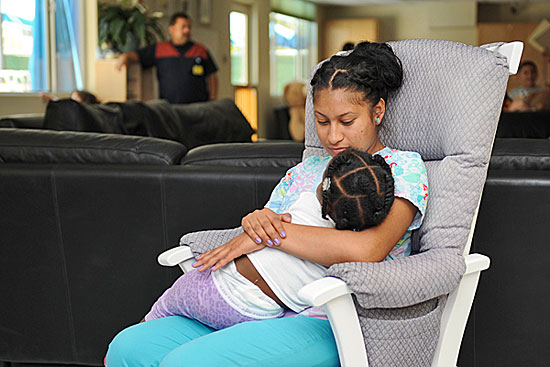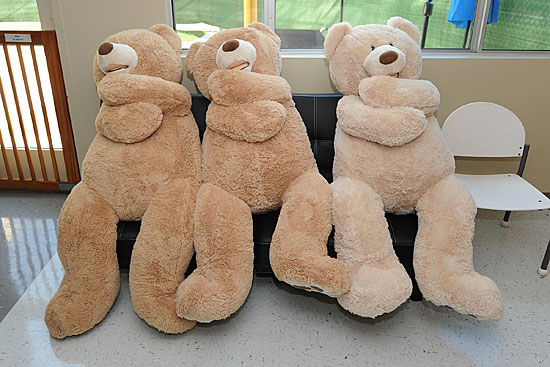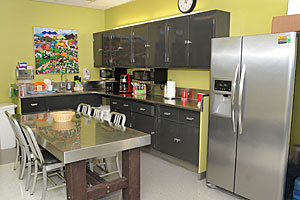A better place for kids to wait
August 22, 2012

A toddler gets a lullaby from a certified nurse assistant at the county's new Child Awaiting Placement Center.
The toddler in the pink shoes had arrived early Sunday, after her single father was taken into custody on a DUI. Social workers called foster home after foster home, but none would take her. One woman agreed, then reneged, saying she couldn’t handle a 21-month-old baby. A grandmother was willing, but her home wasn’t safe.
As precious hours passed, the frustration continued. But there was at least one consolation for the displaced child: For the first time in nearly a decade, tots in her situation had somewhere to wait besides the Department of Children and Family Services command post. When bedtime came, the toddler got a warm bath, a hot meal, a clean crib and a loving shelter in a brand new county center for children awaiting foster care.
Tucked into a corner of the Los Angeles County-USC Medical Center campus, the county’s new Child Awaiting Placement Center has been operating to rave reviews since July 16. The CAP Center can feed, house and care for as many as 15 children up to the age of 10 while DCFS workers canvass for foster homes.
The center opened after reports last year that DCFS was housing children in the department’s Emergency Response Command Post when social workers couldn’t find placements, and downplaying the situation because they feared repercussions from their managers.
Though the command post was created to investigate child abuse allegations on nights and weekends, it has morphed in recent years into a de facto children’s shelter; since the 2003 demise of the troubled MacLaren Children’s Center, the command post is the only DCFS office that never closes.
But the command post—a suite of offices that moved last year from a Wilshire Boulevard high-rise to the downtown L.A. Mart, which houses high-end furniture showrooms—does not have a state license to house children, and by law cannot provide shelter for more than 24 hours.
Earlier this year, county auditors reported that they had seen as many as 10 infants, children and teenagers at a time sleeping at the command post last year. Some older children had histories of violence and severe mental illness, and some babies were sleeping in car seats.
Meanwhile, auditors found, social workers were struggling to find emergency placements; on one night, 11 of 14 foster care facilities called by command post staffers simply let the phone ring; the other three were either filled, closed or had changed their phone numbers.
“We had all these kids coming in,” says DCFS Regional Administrator Frank Ramos. “And we were trying to make sure they were safe in this business office. But at the same time we also had to respond to, say, officers who just did a drug bust and had called to say, ‘We’re at the home, and we need you to come now.’ ”
Enter the CAP Center, which was conceived two years ago by Dr. Astrid Heger, who directs the county’s 24-hour hub for treating victims of child abuse. Housed in a bright, loft-like space that spans a sleeping area, a big playroom, a child-scaled bathroom, a playground and an eat-in kitchen, the center is adjacent to Heger’s clinic.
“It used to be a child care center for employees and patients at the [County-USC] Medical Center before they moved to their new hospital building,” says Heger, adding that after the move, the area reverted to storage space.
Because children who come to the command post are brought to Heger for medical examinations, she says, she saw the need coming. “All the emergency response workers who were coming in here kept saying, ‘Can’t we just leave these kids here? Because the command post isn’t a very good space for them to be in,’ ” she recalls.
Heger’s operation, a multi-disciplinary project known as the Violence Intervention Program, is publicly funded, but also is subsidized by a foundation; deciding that “if we build it, they will come,” she asked one of her private donors, children’s author Cornelia Funke, to help renovate some of the county hub space.
When the Board of Supervisors inevitably demanded action, she says, the space was prepped, thanks to Funke’s $100,000 donation. DCFS kicked in $40,000 for touch-ups, and the founders of Guess? Inc. donated furniture, adds Heger.
The proximity to VIP ensured that medical care and mental health services would be available if needed; the hospital supplied hot meals for the children. Although DCFS officials estimate the center eventually will cost about $2 million to operate with its own staff, the Department of Health Services has for now sent certified nurse assistants to cover the first two months of childcare. DHS leases the space to DCFS at no cost.
Forty-six children arrived during the center’s first week. On the first Saturday night, 14 of its 15 beds were filled. “There were sisters asleep on the couch with their arms around each other, and a teenaged mom with her 2-year-old over there on a futon,” Heger recalls. “It was the way it should be—everybody was sleeping with real pillows and blankets on real furniture.”
As of last week, CAP had sheltered 194 children, and only one—the toddler in the pink shoes—had overstayed the 24-hour limit. Meanwhile at the command post, which for now remains the waiting area of last resort for adolescents, the headcount of waiting children is down by about 40%, to roughly 50 per week.
DCFS Assistant Regional Administrator Maricruz Trevino, who moved from the command post to run the CAP Center, says the new facility is a godsend, but the county’s work is far from finished. From the strained economy to an increased reluctance among foster parents to take babies, she says, a chronic shortage of willing foster homes continues to plague the county.
“This is wonderful,” she says, as she smiles down at the toddler in the pink shoes, who beams back, proffering a little toy bowl of pretend “soup.”
“But the resources in our community have to be gathered. We have to find a place for more of our kids.”

Like the three bears and their porridge, children awaiting foster care now have a setting that is "just right."
Posted 8/21/12













 405 bridge work causes a stink
405 bridge work causes a stink

